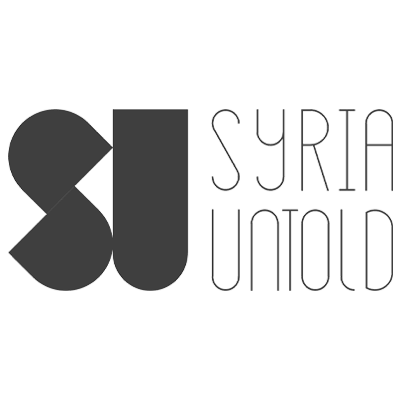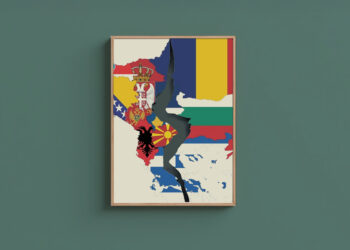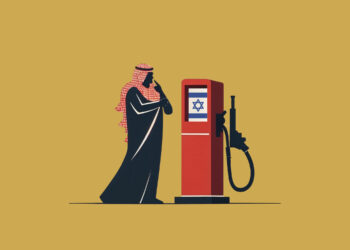Syrian Artists turned towards creativity in the face of the February 6th earthquake catastrophe. The different ranges of themes they addressed show particularly the reality of the Syrian people prior to the natural disaster and their permanent struggle for survival.
This article is part of a dossier in partnership between SyriaUntold and Orient XXI, exploring the consequences of the devastating earthquake that struck Turkey and Syria in February 2023.
Theories of aesthetics and psychology have long established a connection between pain and creativity. Creativity is often seen as the result of an escalation born out of repression or suffering. As Khalil Gibran wrote, “In pain, a person shines.” This association between pain and creativity reached its peak during the Romantic era, where artists were portrayed as individuals living with internal pain that drove them towards creative expression. With the rise of the expressionist movement, pain not only became a driving force for creativity but also emerged as a subject in the poetry of William Butler Yeats and Samuel Taylor Coleridge, as well as in visual arts, like in the works of Edward Munch. On the other hand, and throughout history, human civilization has produced artistic and literary works depicting disasters and natural calamities. Literature is loaded with tales of floods, plagues, volcanic eruptions, and fires, which serve as crucial events in major works of literature and art. In 2016, the Egyptian author Sayed El-Bahrawy published a book titled “In Praise of Pain.” However, what motivates individuals to turn towards creativity in the face of tragedy? Is it solely a desire for self-expression, or does it reflect a collective human response to disasters and catastrophes? By examining the themes and techniques employed in Syrian artworks related to the earthquake that occurred on February 6, 2023, affecting extensive areas in Turkey and Syria, we can gain insight into the factors that drive people towards creativity during moments of catastrophe and calamity.
Syrian artistic works encompass a range of attempts to express not only the catastrophic event itself but also, more specifically, to analyze the reality of the Syrian people prior to the natural disaster. These works predominantly focus on the enduring tragedy experienced by Syrians amidst the political, social, and economic situation that have afflicted the society for years. While certain artistic works may depict the earthquake catastrophe, the majority delve deeper into the lived experiences of the Syrian people, encompassing oppression, war, displacement, life in camps, and the desperate struggle for survival, including the dreadful journeys on perilous boats.
The analysis of these artistic works reveals four recurring themes that emerge prominently in the artworks addressing or expressing the earthquake catastrophe. In this article, we will address these four themes and examine how they are portrayed in the artistic pieces.
The Image of Humanity’s Venture into the Abyss
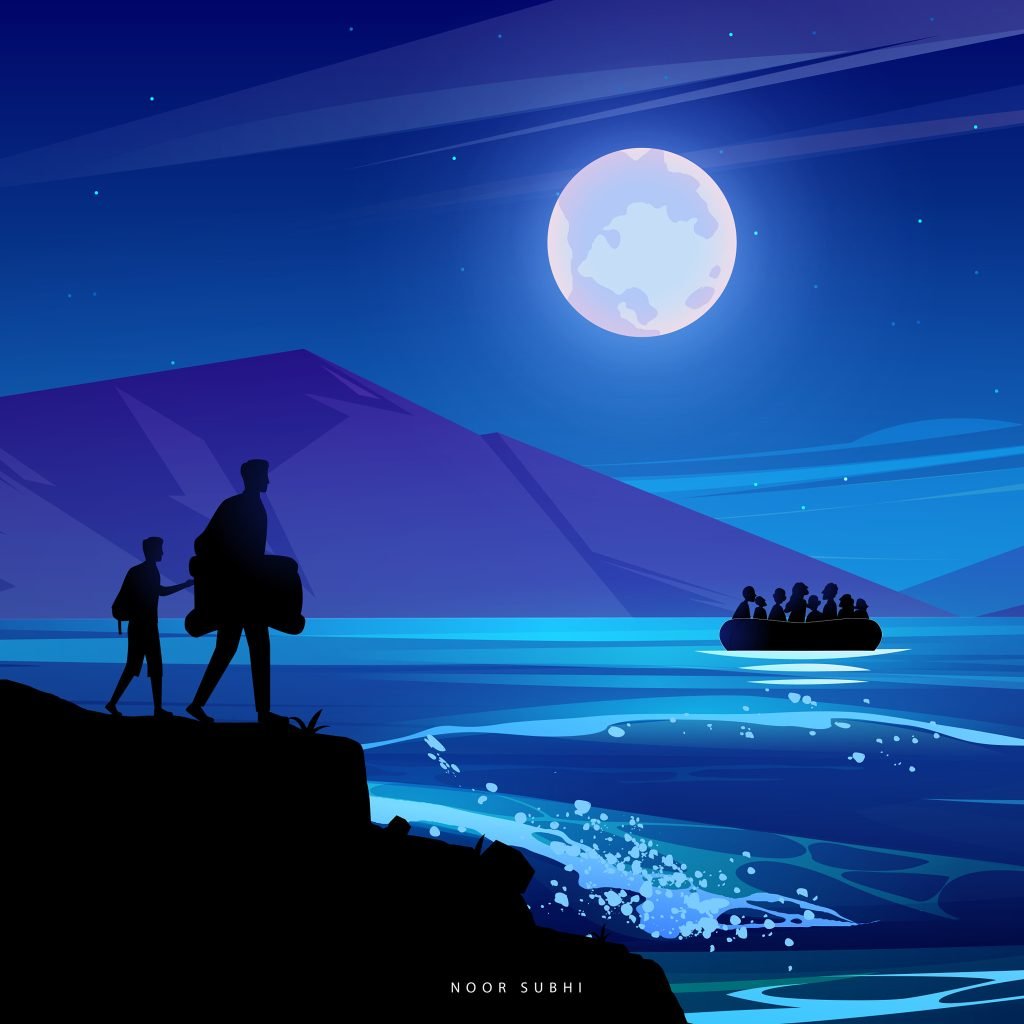
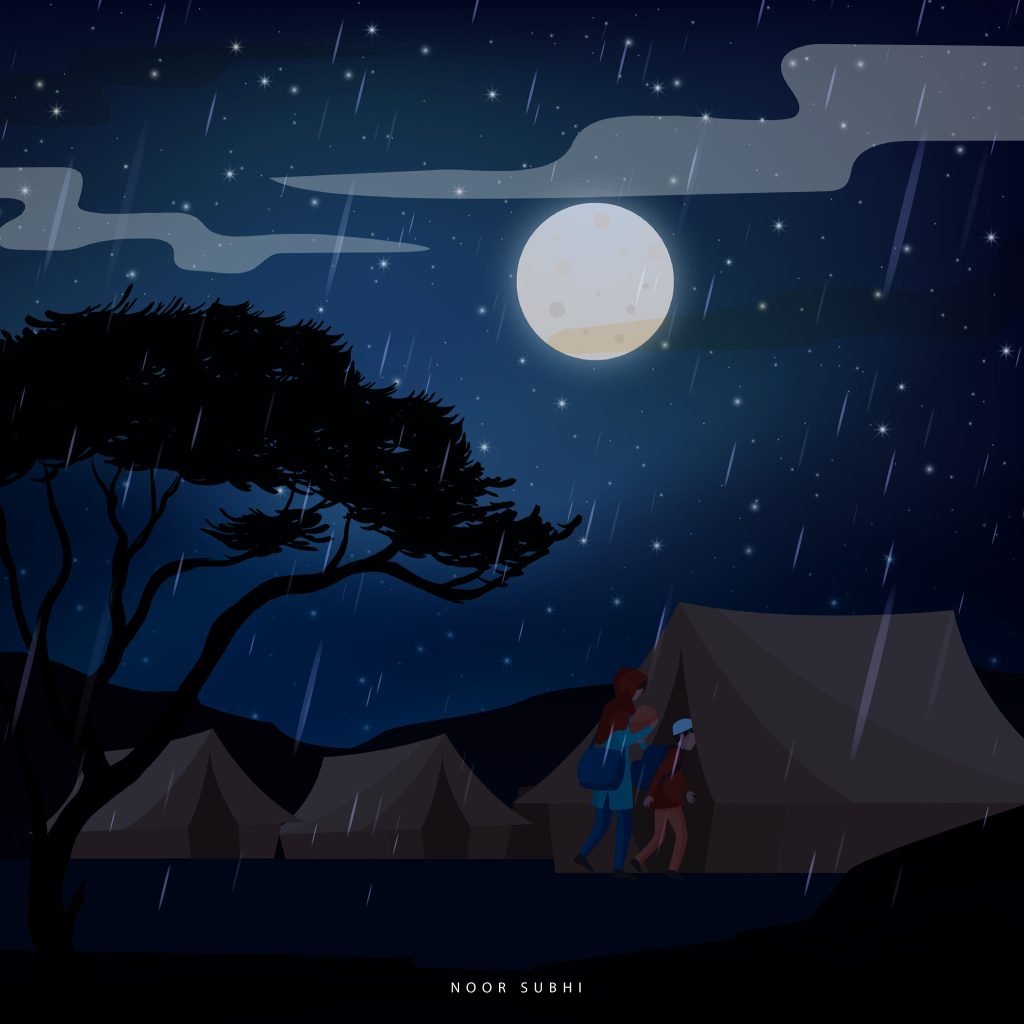
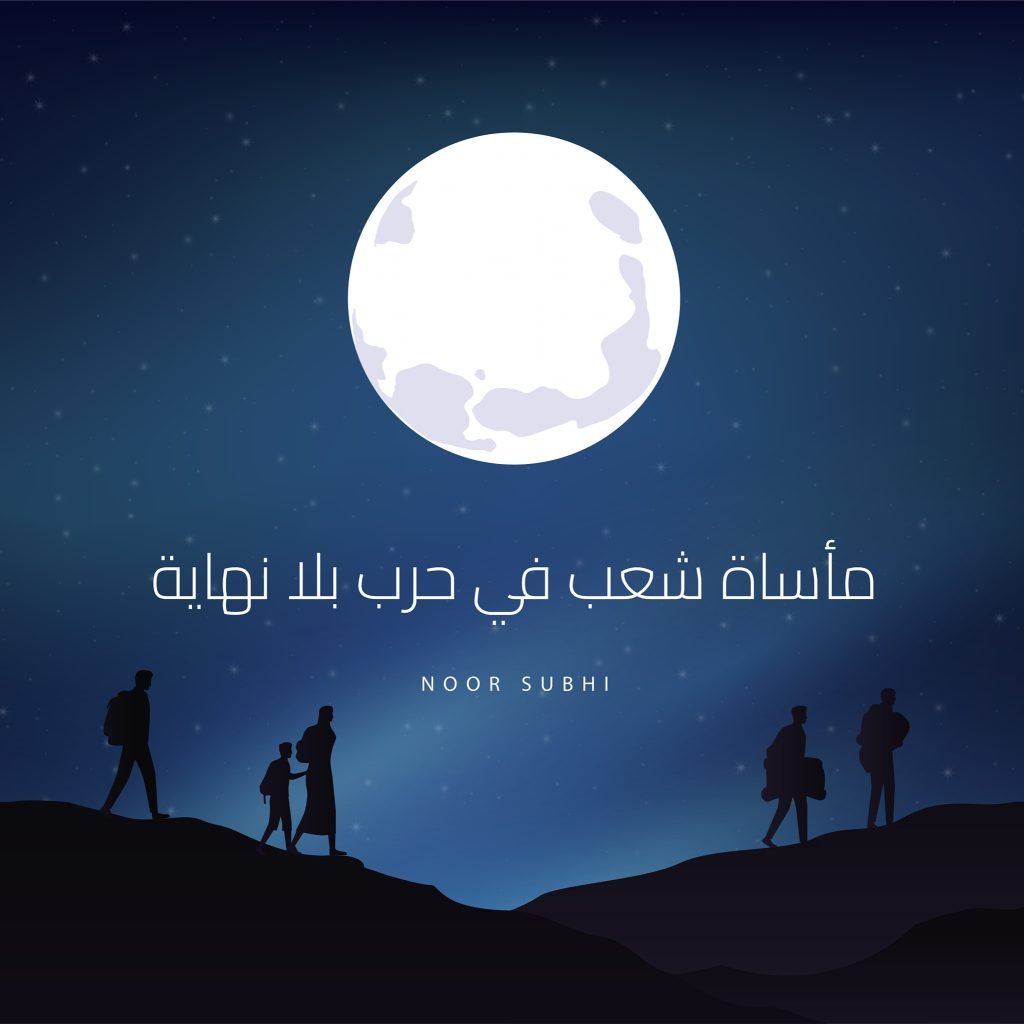
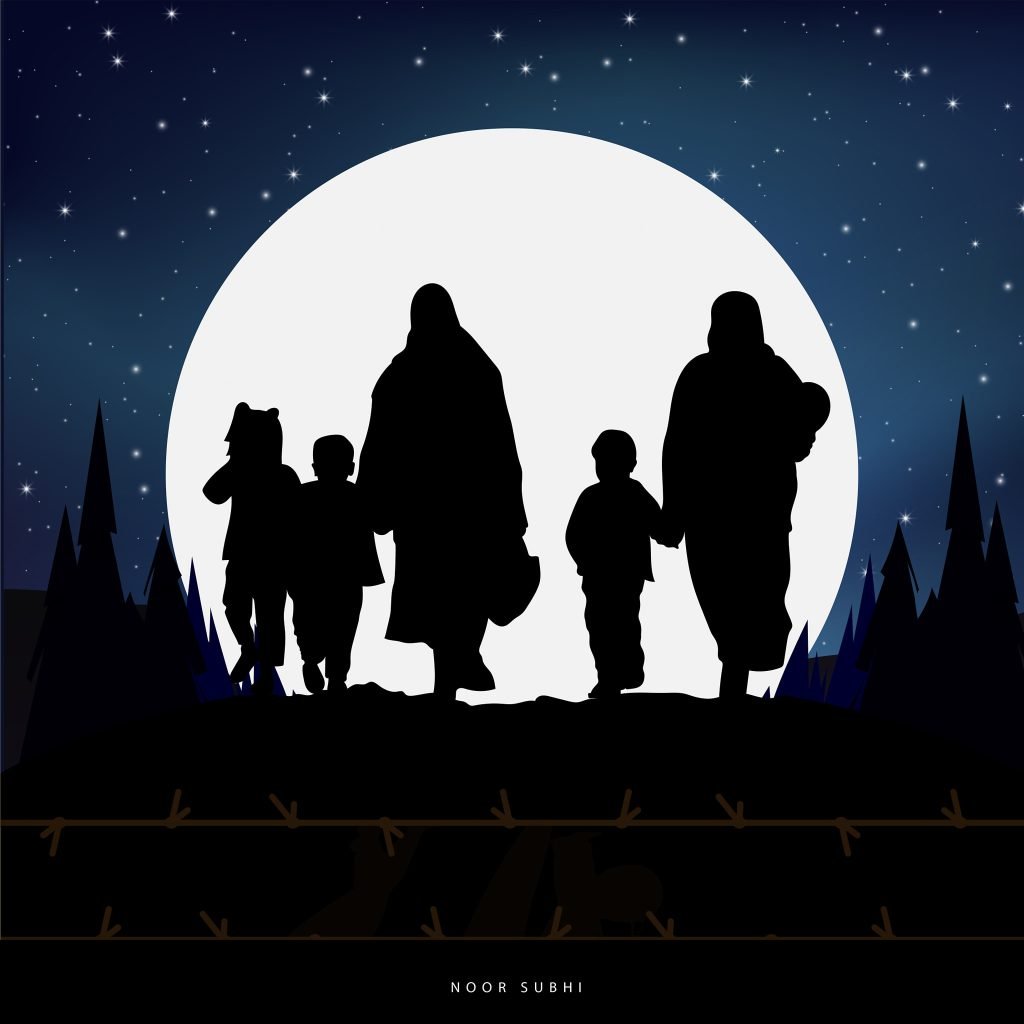
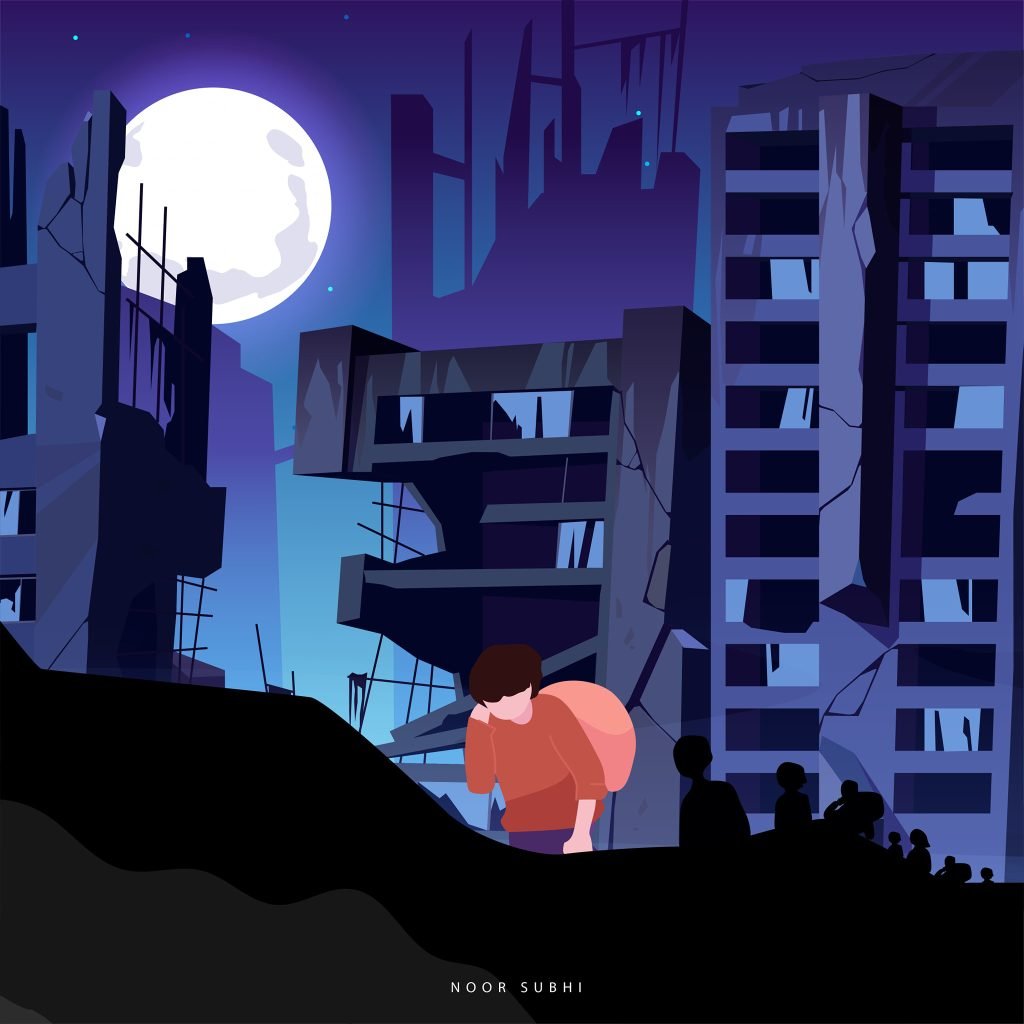
Syrian Artists turned towards creativity in the face of the February 6th earthquake catastrophe. The different ranges of themes they addressed show particularly the reality of the Syrian people prior to the natural disaster and their permanent struggle for survival.
This article is part of a dossier in partnership between SyriaUntold and Orient XXI, exploring the consequences of the devastating earthquake that struck Turkey and Syria in February 2023.
Theories of aesthetics and psychology have long established a connection between pain and creativity. Creativity is often seen as the result of an escalation born out of repression or suffering. As Khalil Gibran wrote, “In pain, a person shines.” This association between pain and creativity reached its peak during the Romantic era, where artists were portrayed as individuals living with internal pain that drove them towards creative expression. With the rise of the expressionist movement, pain not only became a driving force for creativity but also emerged as a subject in the poetry of William Butler Yeats and Samuel Taylor Coleridge, as well as in visual arts, like in the works of Edward Munch. On the other hand, and throughout history, human civilization has produced artistic and literary works depicting disasters and natural calamities. Literature is loaded with tales of floods, plagues, volcanic eruptions, and fires, which serve as crucial events in major works of literature and art. In 2016, the Egyptian author Sayed El-Bahrawy published a book titled “In Praise of Pain.” However, what motivates individuals to turn towards creativity in the face of tragedy? Is it solely a desire for self-expression, or does it reflect a collective human response to disasters and catastrophes? By examining the themes and techniques employed in Syrian artworks related to the earthquake that occurred on February 6, 2023, affecting extensive areas in Turkey and Syria, we can gain insight into the factors that drive people towards creativity during moments of catastrophe and calamity.
Syrian artistic works encompass a range of attempts to express not only the catastrophic event itself but also, more specifically, to analyze the reality of the Syrian people prior to the natural disaster. These works predominantly focus on the enduring tragedy experienced by Syrians amidst the political, social, and economic situation that have afflicted the society for years. While certain artistic works may depict the earthquake catastrophe, the majority delve deeper into the lived experiences of the Syrian people, encompassing oppression, war, displacement, life in camps, and the desperate struggle for survival, including the dreadful journeys on perilous boats.
The analysis of these artistic works reveals four recurring themes that emerge prominently in the artworks addressing or expressing the earthquake catastrophe. In this article, we will address these four themes and examine how they are portrayed in the artistic pieces.
The Image of Humanity’s Venture into the Abyss
The graphic designs presented by artist Noor Subhi exemplify this theme. Through five designs titled “Tragedy of a People in an Endless War”, the artist portrays various aspects of Syrian reality, between displacement, perilous journeys in boats of death, seeking refuge in harsh camps, and the final image focusing on the state of displacement due to destruction. In this image, a young man is depicted walking alone, hunched over, walking away from the rubble of buildings behind him. Each image in this series encapsulates the enduring tragedy faced by the Syrian society, after years of displacement and escape from death, whether caused by wars or earthquake. This sentiment is powerfully echoed in the artwork of the artist Mustafa Jacoub titled “Syrians”. Jaboub illustrate a group of people in distance who appears to walk in an infinite space, devoid of hope to reach a destination or transition from one point to another. The stark contrast between the black shades representing the human presence and the spacious spaces exclusively white envelops the movement of group in a sense of futility and absurdity. The moving shadows of the group of people are reflected on the ground, resembling the shadows of nonexistent ghosts. The symbolism of human’s migration or a group of people’s migration has been extensively employed by artists to express the Syrian condition. This indicates a direct connection between addressing the earthquake and the state of displacement and migration experienced by Syrian society prior to the earthquake.
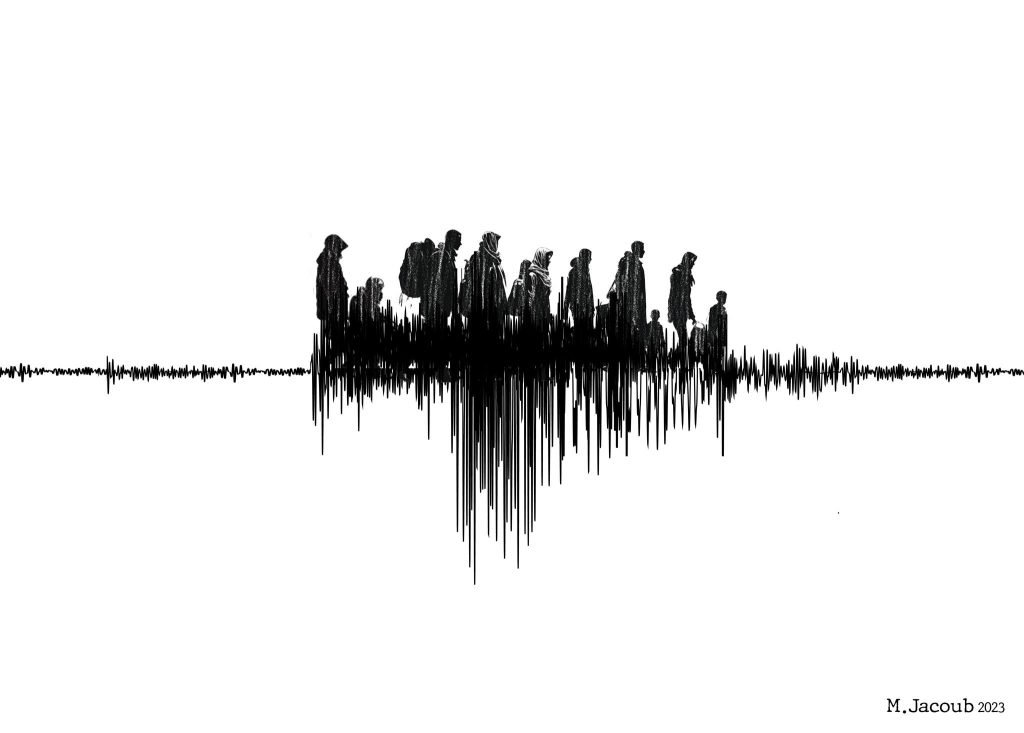
As for the paintings, we can contemplate the artwork titled “One on One” by the artist Tarek Butayhi. Here, a man in a constant state of displacement or movement is depicted embracing a child, with his features obscured behind a red-colored head. This painting transitions from the collective movement of displacement to individual movements. While the man hugs the child, their presence fades amidst the surrounding color palette, conveying a sense of dispersion and loss. The journey of displacement portrayed in this artwork is not futile but rather loaded with a wretched expressive charge. It depicts the man and the child in a state of confusion amidst their surroundings. The alignment in this painting occurs between the individual and the desolate or enigmatic space. While the figures in the artwork are in a state of movement, it is a wandering movement within a static world, just like the mystery surrounding them.
Childhood as an Expression of Tragedy
Artists often incorporate childhood into their artworks to convey tragic emotions. In many pieces featuring migrating human groups, children play a significant role. For instance, Fadi Toon depicts a child curled up in a state of tears, surrounded by destruction on all sides. Above the child, the figures of his lost family and dog are portrayed in his artwork. This graphic design effectively captures the child’s anguish and suffering, as if he has just realized the losses he has endured and stands before the viewer, who is witnessing his losses and the loss of his family.
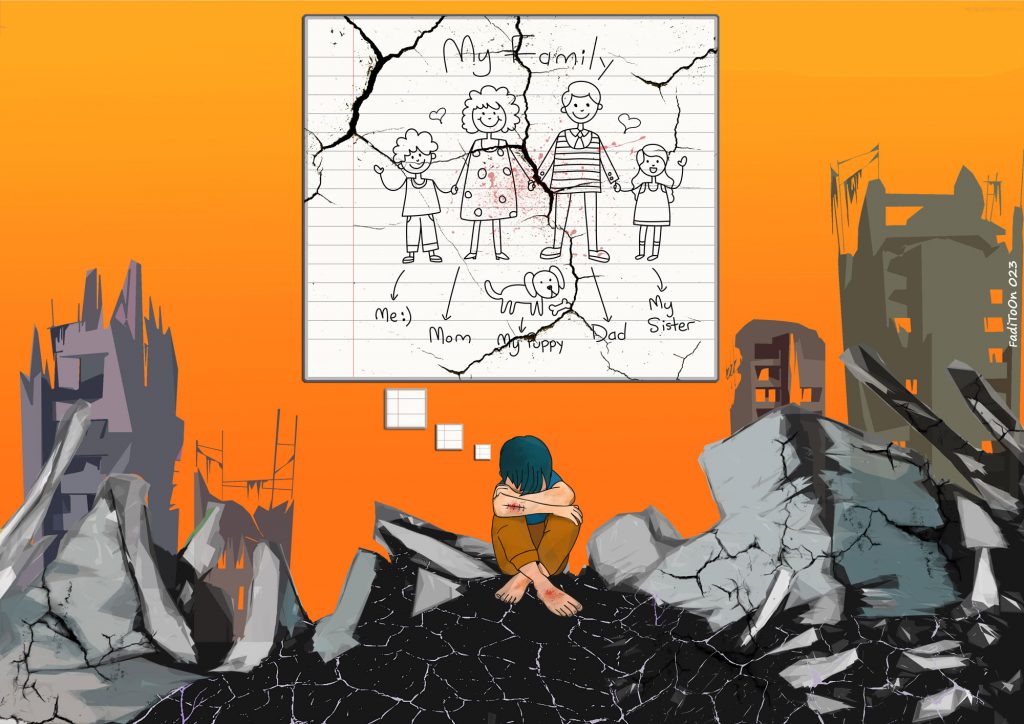
On the other hand, Maysoon Alam Aldin relies on a somber and bewildered expression on the face of a child in her painting titled “Son of Intense Pain.” The child’s features occupy the entire surface of the artwork, serving as an expressive portrayal of the sorrowful and disoriented childhood. Symbolically, it represents the dimensions imposed by tragedy, depicted through a color palette ranging from brown and black to gray. While Toon’s painting includes a bird next to the child’s face, providing some solace amidst the intense pain, Alam Aldin’s painting features the child with one visible eye while the other is covered by a stick. In both cases, the child serves as a metaphor for the artist’s personal expression, with the titles directly addressing childhood, pain, and the accumulation of misfortunes.
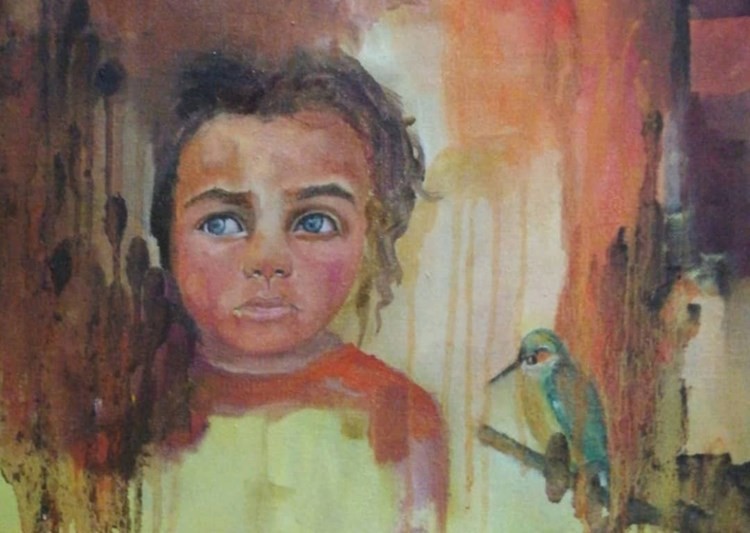
Similarly, Sara Khayat employs a style reminiscent of comic book illustrations in her artwork. She portrays a red-haired girl folding herself as if seeking protection from the earthquake aftermath. The girl appears lonely within a house adorned with broken and crumbling family photographs hanging on the walls. This painting shares similarities with Toon’s sketch, as children experience the moment of tragedy directly before the viewer’s eyes, as if the earthquake is happening in real-time through the artwork. At the bottom of the painting, a depiction of a house flying with a red balloon implies the loss of the family’s home and shelter.
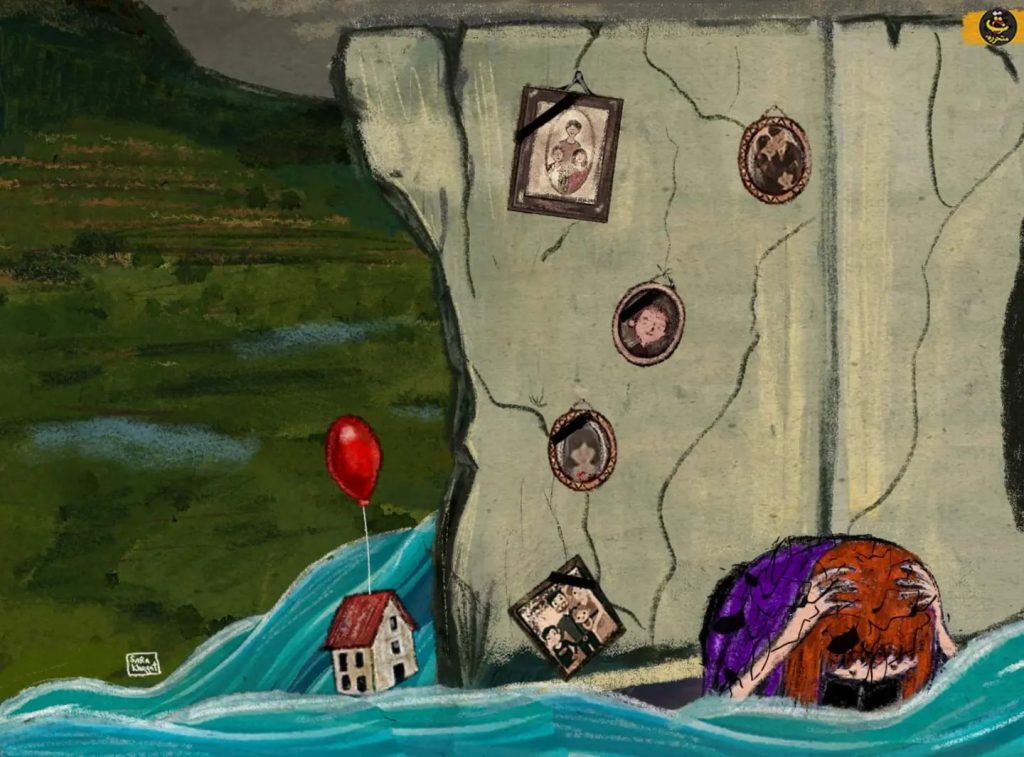
In contrast, Samer Tarabichi presents a more intense portrayal by depicting a sleeping, unconscious, or deceased fetus atop a pile of rubble. Sheets of white debris surround the child’s body, indicating his passing and confinement within layers of white stones. The title of the painting, “Hush Hush baby’s sleeping”, increases its poetic expression, as if it deludes the fetus itself, suggesting a rest rather than the impending death depicted in the artwork.

While the artist Gulnar Hajo chooses a completely different technique in her engraving work. The image features a girl formed by long, extended lines in black and white, covering the entire surface. She is depicted flying over houses and blending with the surroundings. However, the fragmentation of her body and the separation of her feet from her hands and waist evoke a sense of anxiety, reflected in the painting’s title, “Anxiety.” While childhood’s presence expands and occupies the entire surface of the image, it carries an implied meaning in the artwork, as childhood and place are intertwined, constantly shaping one another. Since the place is subject to the geometric logic of an earthquake, the girl’s body in the image lacks the interconnected relationships between its body parts.

Fusion between the Human Body, Rubble, and Destruction
This category of artworks explores the fusion between the human body, mostly one of its organs, emerging from under rubble and destruction, serving as a recurring motif used by many artists to convey the delicate balance between life and death, existence and absence, survival and war absurdity. These artworks depict scenes filled with rubble, like Abdullah Murad’s painting “Fracture”, where a hand emerges in one side of the painting, representing the realm of life. This painting exemplifies this objective theme, taking it to an extreme level. The title and imagery suggest a fracture or crack in the earth, but the chosen colors hint that the fracture takes the form of a human body. The cracks become a solid body, and the stillness portrayed in the painting gives the impression of witnessing the cracking of a human body along the drawn fracture.

Hazem Al-Hamwi’s engraving work depicts a demolished house devoid of human presence, while Zouhair Hasib overturns this equation by presenting a portrait of a human face in pain, with wide opened eyes and expressions traumatized by the disaster. The portrait is formed by layers of color spaces that resemble adjacent layers of debris, evoking to the viewer his immersion in pain, fear, and loss. Hasib titled the painting “Syrian Pain.”
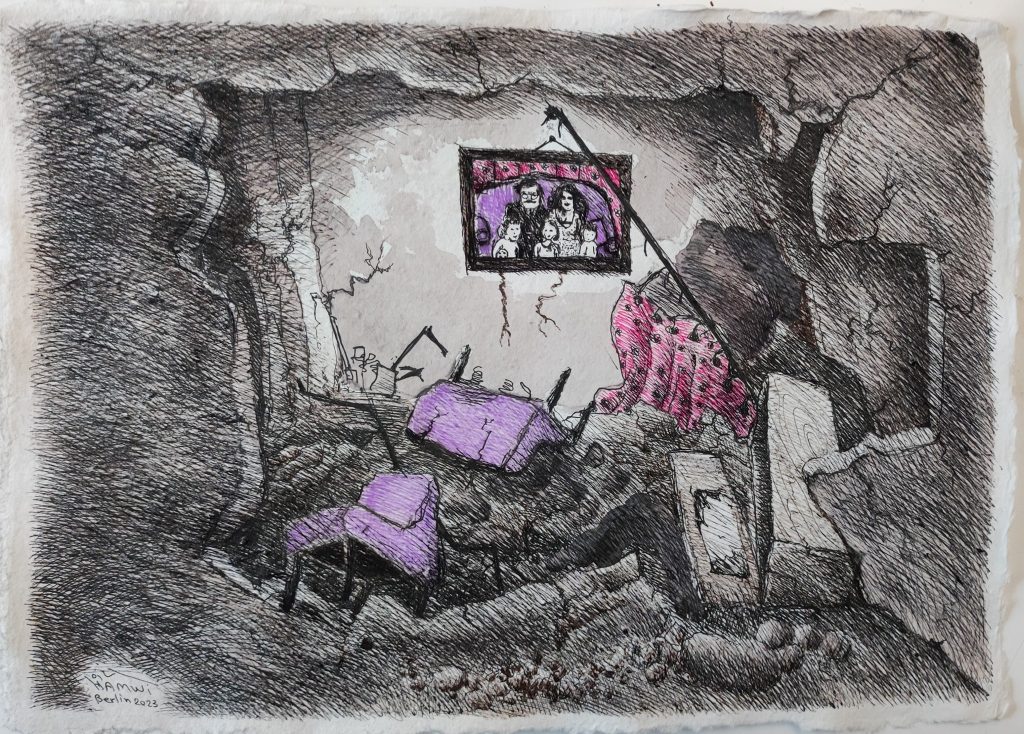
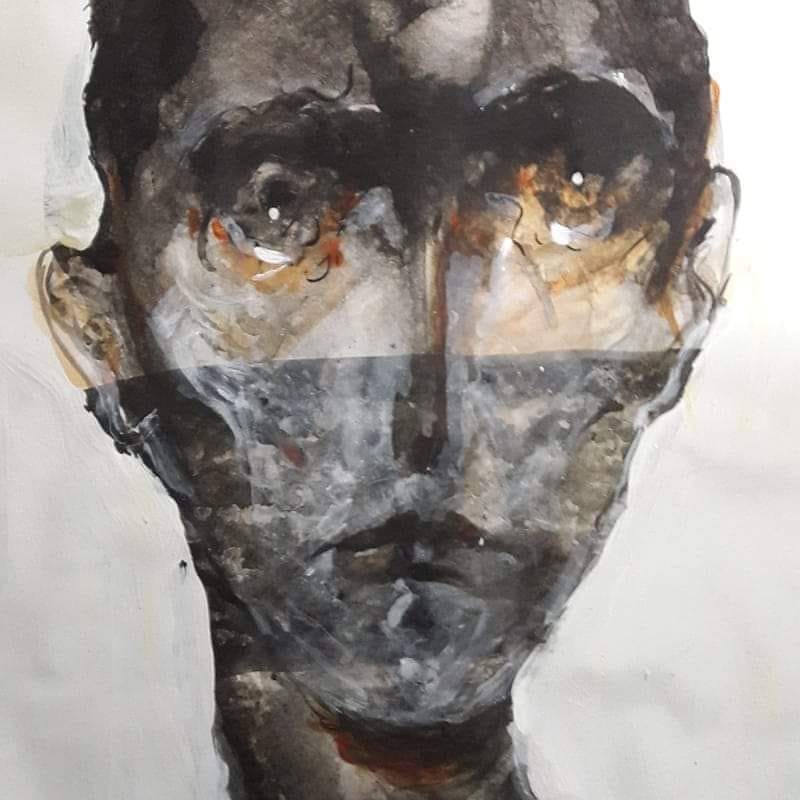
All the above paves the way for the abstraction chosen by Hanadi Yousfan in her painting entitled “Is there no end to this endless night”? Characterized by a high degree of abstraction, the black and white shapes and forms across the painting suggest a human presence behind random black blocks. At times, the abstracted mass resembles anguished and distressed human faces, while in other interpretations, it represents layers of destruction. This painting showcases a profound convergence between human presence and chaotic debris.
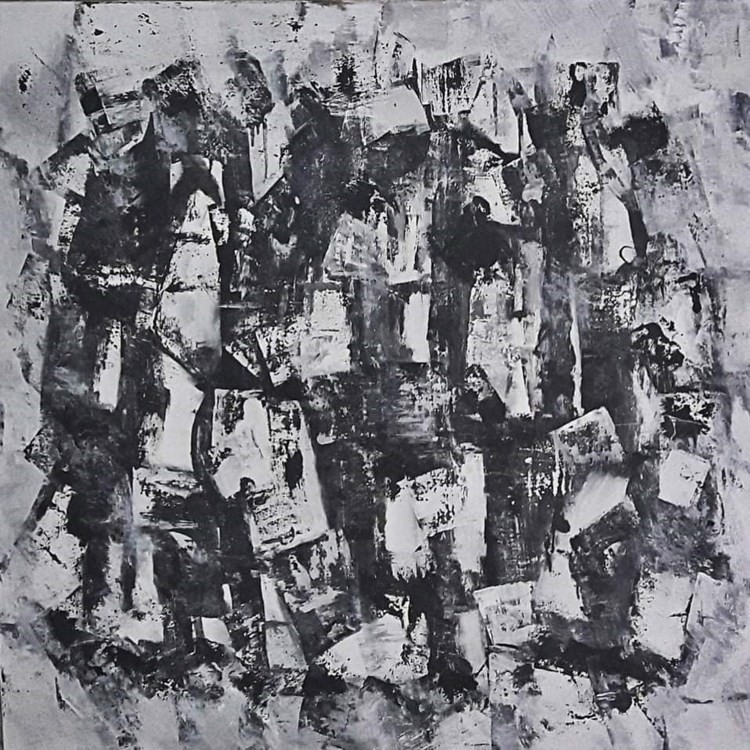
Once we recognize the repeated theme of the fusion between human faces or bodies and masses of rubble and destruction, the transition to two distinct paintings by the artist Ibrahim Barghout becomes logical. The first paintings, “Under the Rubble” depict human forms amidst the wreckage, but very simplified, sleeping or lying on the ground, the land of nowhere, or the land of everywhere. The fallen bodies among the debris create their own presence. In some parts of the painting, human elements intertwine with the components of rubble, thus merging with the entirety of the place. The painting presents intense colors of green, red, and blue. However, these colors do not suggest delicacy or radiance, but rather trouble the viewer’s gaze. The painting imposes a sense of confusion upon the viewer, stretching from the expressions of the painting’s various characters. The children and women, who represent most of the human figures, gaze at the viewer with a look of desperation, as if they have just lost their souls. It is not due to the earthquake but rather to the intensity of grief and pain that unifies the characters in the painting. The second painting, titled “Storm Debris,” completely repeats the theme, style, and colors of the previous painting, but adopts a vertical orientation in relation to its depicted scene.
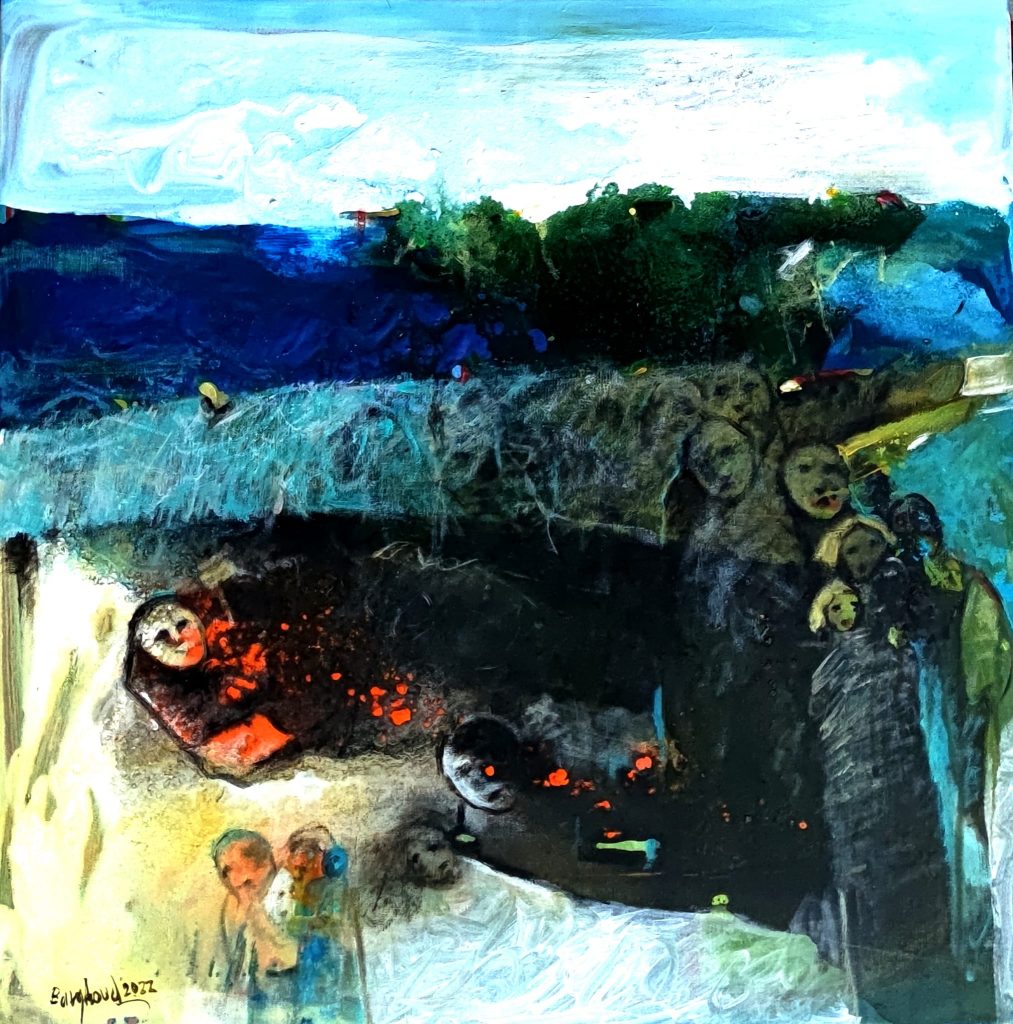
The artist Khaled Najjar evokes human figures that resemble animals or cartoon characters. Among the buildings, a green-faced creature stands in the middle of the painting. Despite being a mythical creature, it possesses the ability to express its inner emotions. However, its large size, comparable to the towering structures, symbolizes rupture and cracking, reflecting the division between the human face, the buildings, and the houses, as well as the fissures in the earth. Along the character’s front facade, we catch a glimpse of an extended rupture embedded in him. Titled “Heartache”, this painting further explores the themes of empathy and solidarity during times of disaster, not only at the human level but also extending empathy to other creatures. It is crucial to highlight that solidarity serves as a fundamental motivation for the creative process amidst crises and disasters.
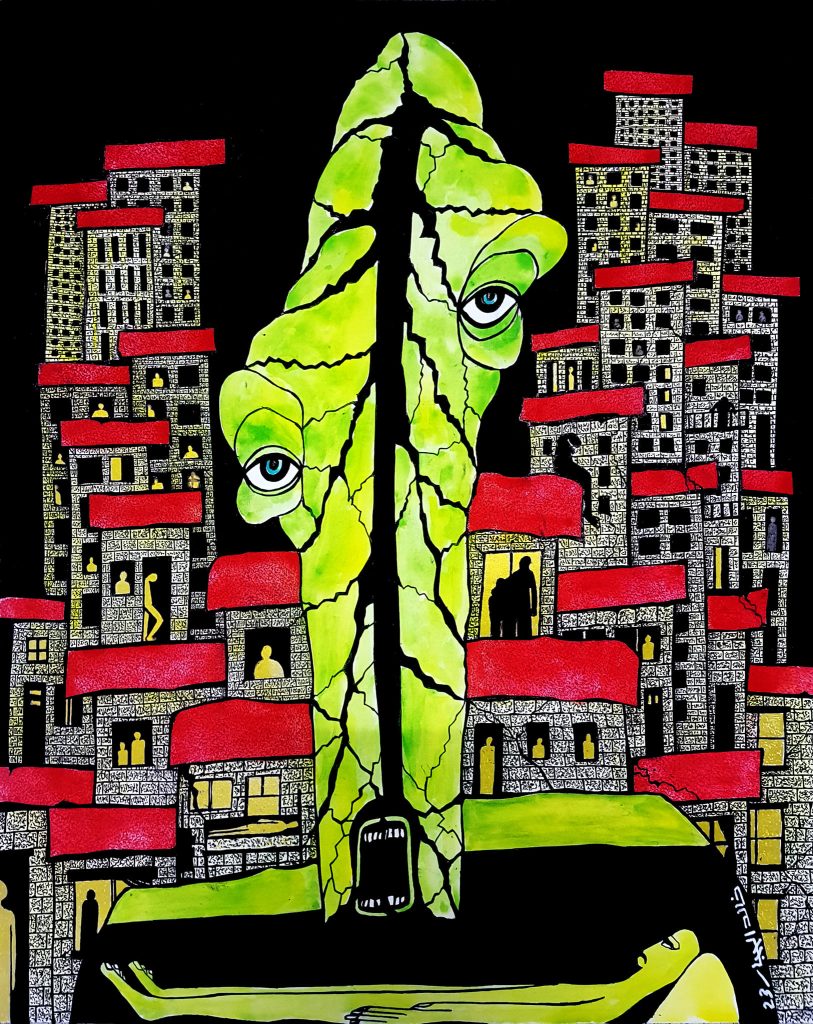
The artists who present their paintings and drawings to express the tragedy of the disaster may not necessarily be directly affected by the earthquake. Artist Nehad Ghali’s painting, titled “Perhaps They Will Survive,” represents the objective of transforming artwork into a message of solidarity or even a proactive attempt to alter the fate of the victims. The painting portrays a mother embracing her children, all of them trapped under debris, which occupies the entire lower part of the artwork. The painting is released by the artist as a hopeful plea, as suggested by the title, “Perhaps They Will Survive”. It is through the impact of the artwork that this is achieved. The painting thus serves as a realistic endeavor to achieve survival for those who have become victims.
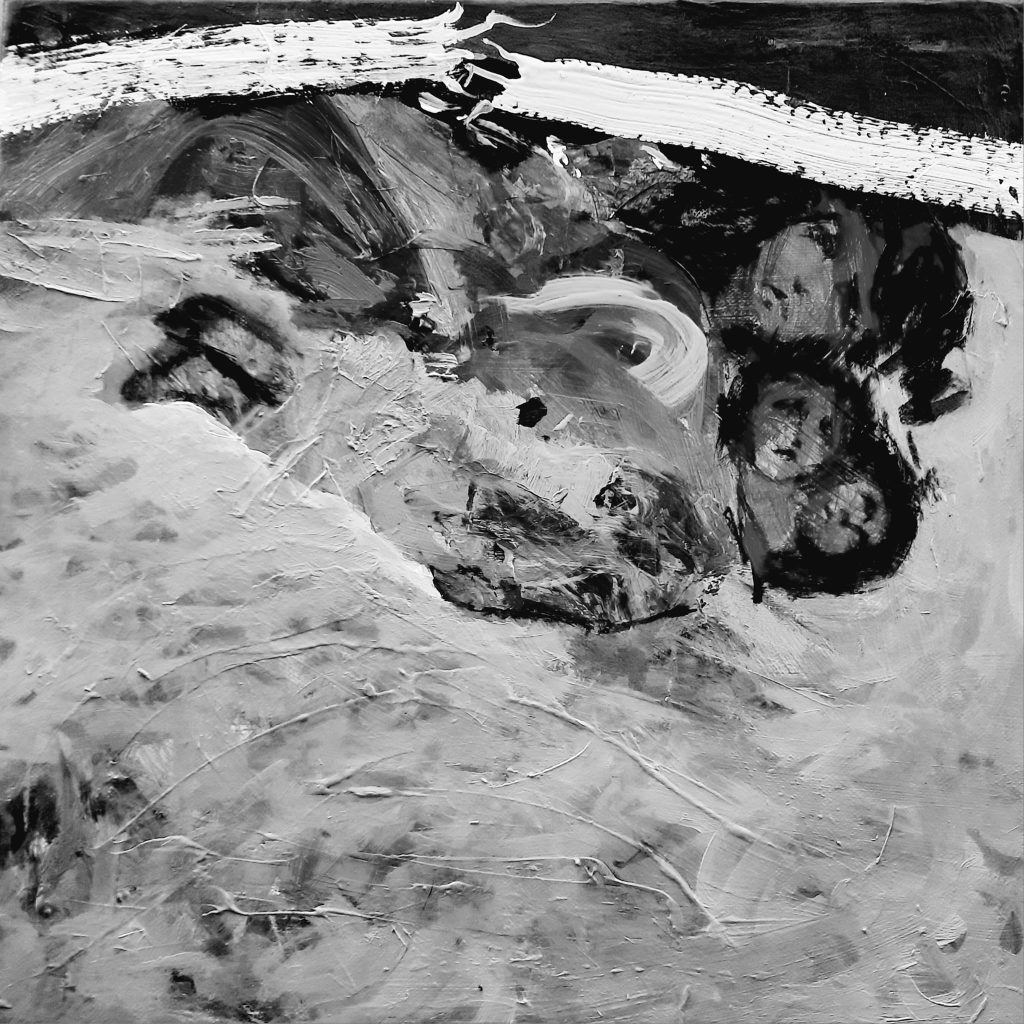
Lastly, within this category, we encounter a noteworthy artwork that expresses the yearning for survival and the perseverance of existence. It portrays four hands struggling to escape from the abyss of rubble and scattered stones, encompassing the entire canvas. Only the fingers of these hands, striving to cling to life or grasp one another, punctuate the scene, evoking both a desire for survival and a yearning for death. Artist Suheil Dhubian employs engraving techniques to represent the fusion between the cracked rubble and the complex lines and contours of the human hand.
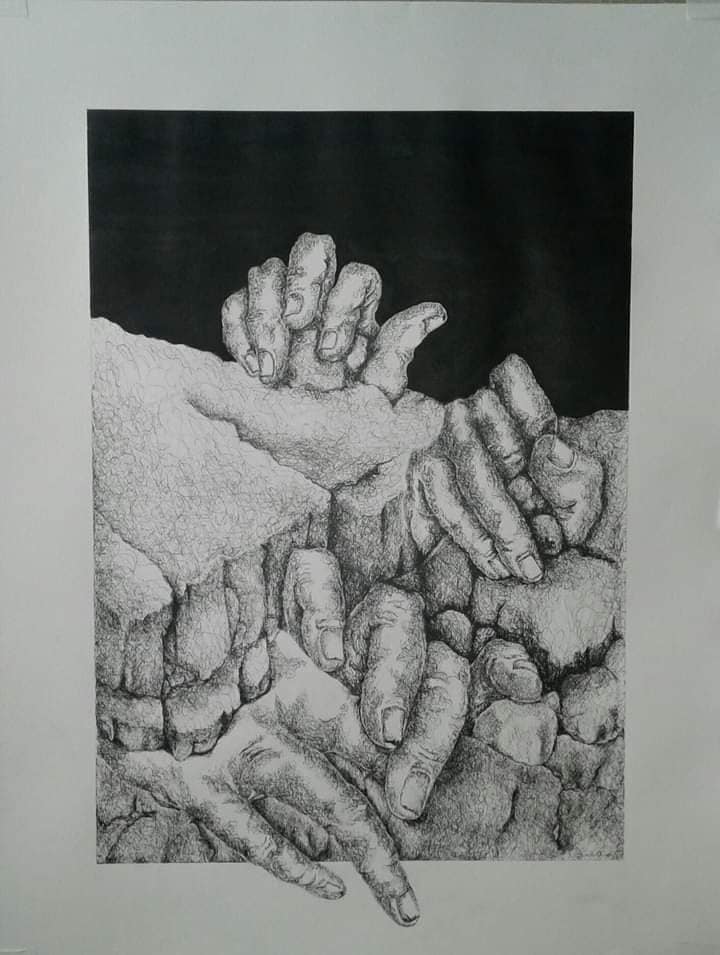
On a different note, artist Shamsia Hassani captures a family scene at the moment of the collapse of the building in which they live. The family’s physical organs turn into crumbling stones, falling alongside their own body parts.
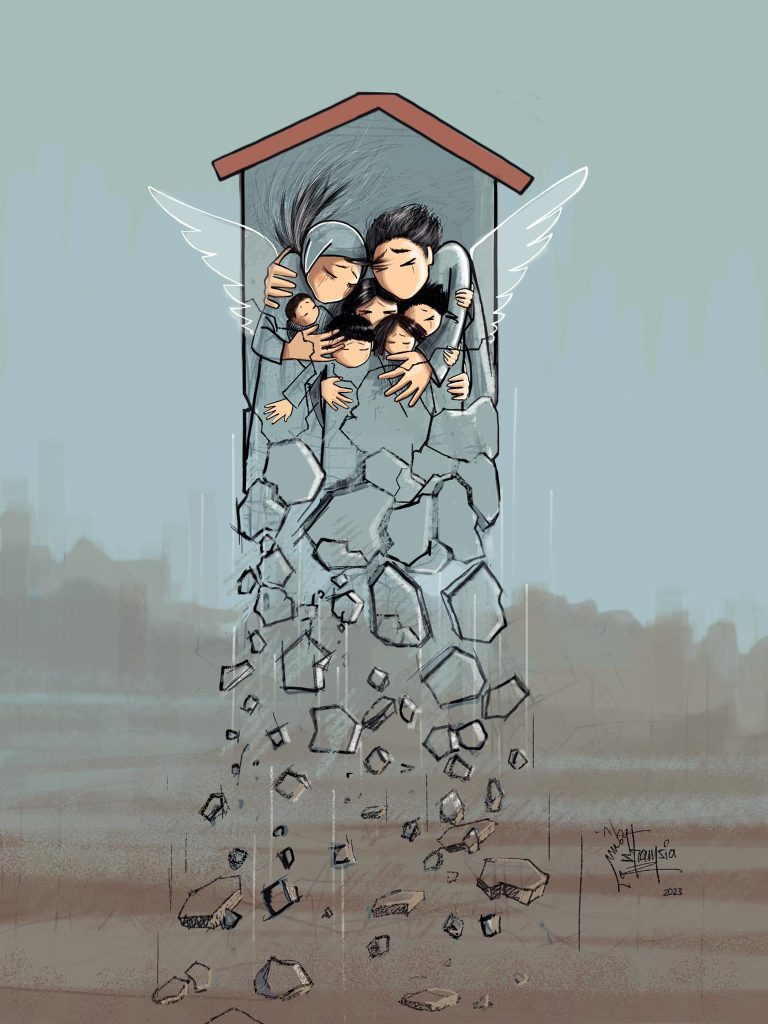
Artwork as a Letter of Communication and Appreciation
We have dedicated the final category to a central theme in the factors and motives of artistic expression during disasters. While there are only two artworks featured here, their significance lies in acknowledging the role of art in fostering solidarity, empathy, and expressing value and appreciation. This motivation has been reiterated in various texts, media testimonies, and now finds its manifestation in artistic expression. The artists behind these works convey messages of gratitude through their artwork, whether in the form of paintings or digital designs, to the entities that assisted them during the earthquake. In both artworks, the message of appreciation is directed towards the Civil Defense team in the Idlib region, also known as the White Helmets. Images of the Syrian Civil Defense teams quickly circulated on social media moments after the earthquake struck the border region between southeastern Turkey and northwestern Syria on 06-02-2023. These teams worked tirelessly to rescue individuals trapped under the rubble in the affected areas of northern Syria. Other images depicted dozens of survivors who were saved by these teams, despite the lack of equipment, machinery, and international support. Activists and artists actively created artworks expressing gratitude towards the individuals and workers in this organization. Alongside photographs, numerous artworks related to this theme were created, and multiple media campaigns were launched, designing images and posters to express gratitude towards the organization.
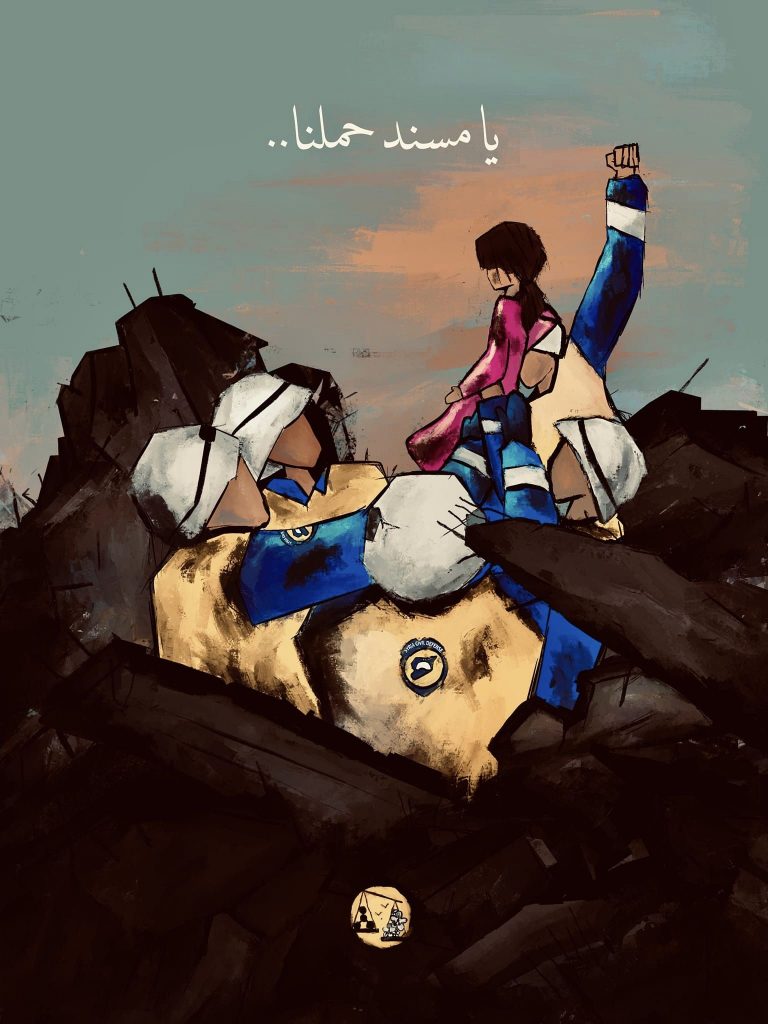
The artwork before us is part of a campaign titled “Ya Masnad Hemelna” (O Supporter, you carried us) with graphic design by artist Ammar Buwaydati. The image depicts a moment of rescue, showing two members of the Civil Defense carrying a child out of the rubble. The artist accompanies the artwork with a text that emphasizes the painting’s content: “O Supporter, you carried us and our soreness. The White Helmets, whoever saves a life is as though he had saved all mankind”. The second artwork is a video art piece by artist Saad Hajo, titled “White Helmets, Peace be Upon You.” In this video, the White Helmets emblem is placed on a flag that flutters and moves in a manner like the constantly displayed Syrian national flag on official television. This video serves as a representation of replacing the national flag with the flag intended to convey appreciation and tribute. Although the video’s duration does not exceed ten seconds, it demonstrates great skill in execution and employs cultural and political visual symbols that Syrians recognize, particularly in reference to the official national flag.


